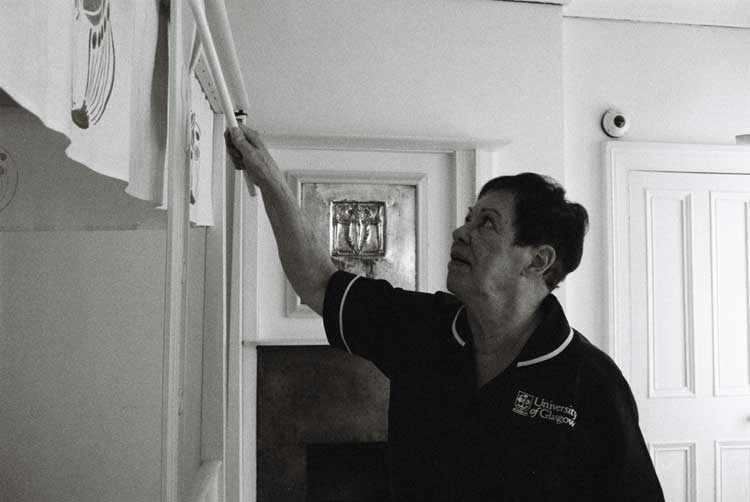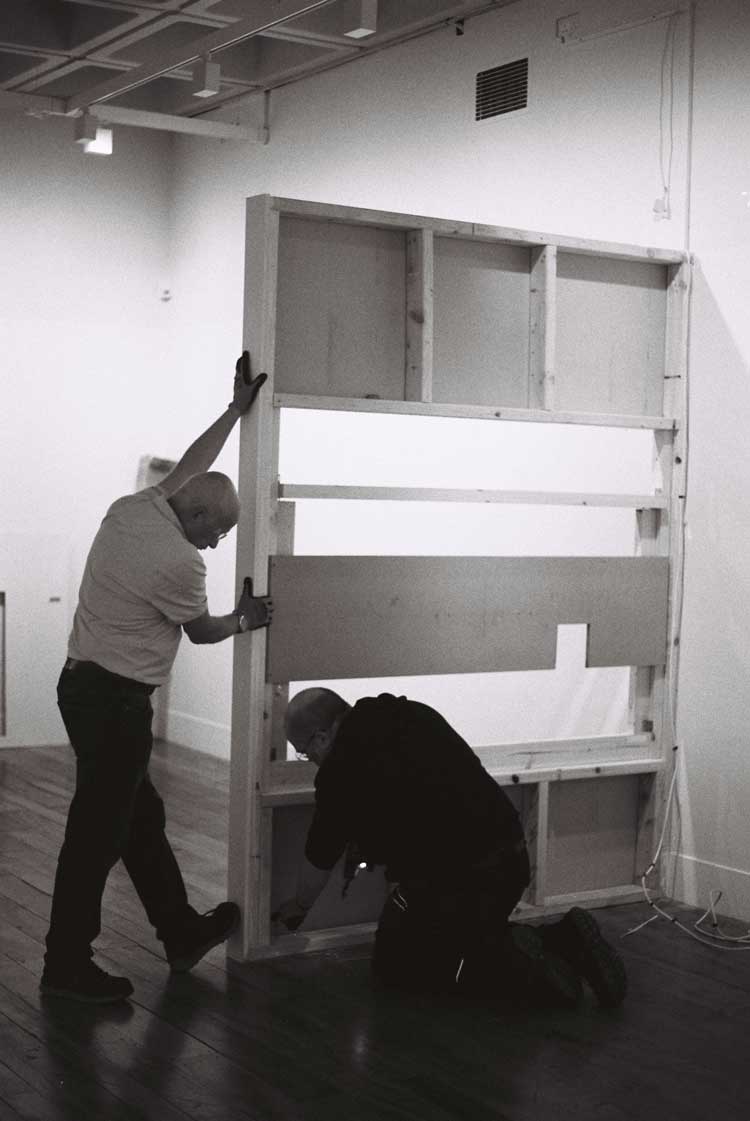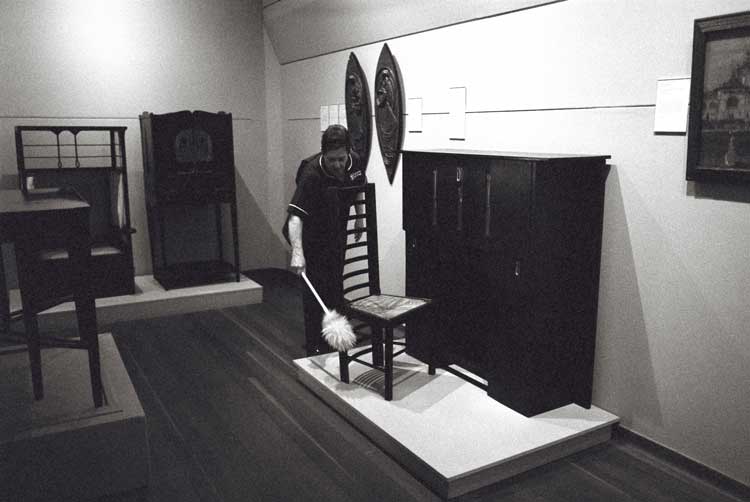-Image4-credit_-Ruth-Clark.jpg)
Assembly, Margaret Salmon, The Hunterian, 2025. Photo: Ruth Clark.
Hunterian Art Gallery, Glasgow
27 June – 19 October 2025
by BETH WILLIAMSON
When it comes to Margaret Salmon’s new exhibition Assembly at the Hunterian Art Gallery in Glasgow, I have to confess to having a connection to the work, historically at least. Salmon’s work is many things, but at its heart it is a socially committed practice where the artist engages with the local communities in Kelvinside and Maryhill where she lives. I was born in Maryhill, as were my mum and my gran. My gran lived in Ancroft Street almost all her adult life and, as a war widow, raised her two children alone while working long hours in the dairy, then in the newsagents, just around the corner. I have childhood memories of playing in that street. It’s something I’ve been thinking about a lot recently as my mum now has dementia and, though her short-term memory is much depleted, her long-term memory remains quite strong and she talks about Maryhill when I visit. Perhaps I bring a certain kind of nostalgic remembering with me to this exhibition, but I hope I am self-aware enough not to allow that to get in the way. Svetlana Boym, in her book The Future of Nostalgia (2001), says: “A cinematic image of nostalgia is a double exposure, or a superimposition of two images – of home and abroad, past and present, dream and everyday life. The moment we try to force it into a single image, it breaks the frame or burns the surface.” So, I leave my nostalgia at the door as there is no place for it to go in this exhibition by Salmon, who is at all times consciously present, here and now, with those she films or photographs or speaks to. There is a particular generosity of time and, more importantly, attention that links to her recollection of Arthur Miller’s words from Death of a Salesman: “Attention, attention must finally be paid to such a person!” Salmon pays attention to everyone and that means people feel valued and valuable.
-Image-6-credit_-Ruth-Clark.jpg)
Assembly, Margaret Salmon, The Hunterian, 2025. Photo: Ruth Clark.
Assembly is an experiment, an exhibition taking place in real time and an exhibition where the artist’s research and process and practice are exposed, presented simply on their own terms, not dressed up. An assembly of disparate objects is strewn across and around a wooden table constructed from a partition wall from the gallery’s previous exhibition. A single training shoe becomes a makeshift vase for some wilting flowers. A pair of hockey sticks become sculpture as they are housed within a Perspex display case. In another case a copy of the New York Times shows the face of weeping woman while, above it, a vase holds more dying flowers. Found objects and handwritten notes are pinned to one wall while a number of photographs fill another. There is a painting by local artist Jo Sunshine, who is partially sighted, and the exhibition title or tag was commissioned from Ronan, who also designed signage for Cafe Hope at G20 Youth Project, just one of the communities with which Salmon collaborates.
,-image-courtesy-of-the-artist.jpg)
Assembly, Margaret Salmon, The Hunterian, 2025. Image courtesy of the artist.
Salmon’s work is a collaboration of the most generous sort. The artist’s film she has made for Assembly, like the exhibition more broadly, will develop in real time with three seasons being presented: Spring, Summer and Autumn. It is a seasonal feast that will shift and evolve with time. Salmon tends to work locally where she finds herself, something that was underlined for her during the pandemic. Such local engagement is not something she undertakes lightly. It is not simply a way of finding material for her artistic practice. Instead, she is socially committed and assembles a cast of diverse voices from among the residents of Maryhill and Kelvinside. Through community outreach, story counselling and cinematic experimentation, Salmon hopes that participants will take something positive from the experience. She describes the resulting film To a God Unknown as “a feminist existential melodrama and ghost story”. It is a deeply personal film that has its roots in the everyday activities of these Glasgow areas and their communities. Salmon uses a “show don’t tell” approach that is perhaps associated with her idea that “as an artist you can also show the change you wish to see in the world”. It is almost as if this is a kind of breathing for Salmon as she quietly films and talks and gives ordinary people and their activities the attention they deserve. Operating from a place of care, the ordinary becomes extraordinary, exposed not for its banality (as might be assumed) but for its sheer wonder. Local singer Pippa Blundell is filmed singing in the artist’s kitchen. As Blundell sings, she leans into her guitar. There is equal focus on her fingers and face, technical skill and emotional investment. Hunterian technicians are filmed dismantling the previous exhibition. Two university cleaners are filmed cleaning the Mackintosh House in the Hunterian, Charles Rennie Mackintosh’s only surviving domestic interior in his native Glasgow. What we have here is a sort of spectrality where Salmon reveals the ghosts in the machine, as it were.

Assembly, Margaret Salmon, The Hunterian, 2025. Image courtesy of the artist.
The film also asks: what is an artist’s film? Because this isn’t mainstream film. It is self-reflexive about its form and its content. When Salmon has to load a new roll of film, the screen goes blank but she allows the audio recording to continue and the sound becomes more all-encompassing for the viewer, a heightened experience. We can hear the conversation carry on while she reloads and the occasional click of a shutter where she captures a still black-and-white image that is later woven into the film. In the case of Sunshine, this acts to remind the viewer of what she must overcome to continue making the vibrant art she does. When the new film is loaded, we hear the sound of the camera once more. Then, we are off, and Sunshine and her world fill the screen again. Appropriately, it is a work by Sunshine that is one of the first things you encounter in the exhibition.

Assembly, Margaret Salmon, The Hunterian, 2025. Image courtesy of the artist.
In other parts of Spring, outtakes and excerpts from Salmon’s film Home (2019) show a young woman caring for her home and children. The observable external events of her life –washing dishes and bathing children, for instance – are filmed in silence. It is only when she looks inward that supportive hands are imagined and gently choreographed movements are seen in ghostly form and accompanied by haunting music. Equally dreamy scenes from the River Kelvin, filmed in 2020, show minnows and children enjoying the water equally. The final seven minutes of the film, featuring Jean and Simone Turrettini Mohr from footage taken in 2018, provide and enchanting close to Spring which nonetheless remains in the realm of the domestic.
How an exhibition comes about, how an institution simply keeps going, also interests Salmon, who turns to the often unseen and unacknowledged labour behind the scenes. I’ve already mentioned the filming of technicians during the deinstallation of an exhibition and cleaners in the Mackintosh House and Hunterian Gallery. Salmon got to know Anne and Rose, talking with them and filming while they went about their work keeping the gallery spaces clean. What becomes clear is just how much pride they take in their work, in a job well done. A gentle touch may remove dust from one of Mackintosh’s signature dining chairs, or a freestanding sculpture in the gallery, but a forensic eye surveys the entire space, ensuring it is spotless and ready for visitors. The importance of what these women do is never in doubt.

Assembly, Margaret Salmon, The Hunterian, 2025. Image courtesy of the artist.
Salmon’s ethnographic eye brings to mind that of ethnographer Judith Henderson and her studies of communities in the East End of London in the 1950s while her husband Nigel Henderson’s photographic experiments in Bethnal Green pushed the limits of photography of the time to photograph the streets and the communities. Ideas of kinship, closeness and where people live send me searching for my copy of Michal Young and Peter Wilmott’s well-known book Family and Kinship in East London, first published in 1957. Yet we are in Glasgow, not London, and almost 70 years on. What resonates, however, are these ideas of family and kinship. For me, it is my family and its history in Maryhill. In Salmon’s case, her contemporary kinship with the local communities she works within perhaps provides a model for a more ethical and inclusive art practice, one that genuinely supports a shared culture for all rather than an elite culture for the few. Reflecting this place back on itself, she says, creates a space for “conversation, awareness and humanizing discourse”. The complexities of contemporary life in urban communities that come under Salmon’s lens are scrutinised, but with kindness. It is bearing witness to people’s ordinary lives that they are validated, shared in, sat alongside and ultimately cared for in a manner that opens up new possibilities.
• Spring runs from 27 June to 17 August, Summer from 19 August to 21 September and Autumn from 23 September to the close of the exhibition on 19 October.